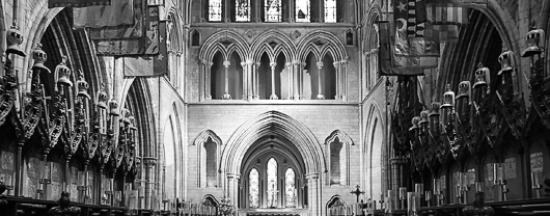St. Patrick’s Cathedral dates from 1220-1259. It was constructed on the site of an ancient well (supposed to have been used by Saint Patrick himself). The building replaced an earlier wooden church.
Archbishop John Comyn was responsible for elevating Saint Patrick’s to Cathedral status but the credit for its construction must go to Archbishop Luke (1219-1260). He built a Gothic cathedral in a cruciform shape. It is believed that the design was based on Old Sarum Cathedral, near Salisbury in England.
The building constantly evolved over the course of the next 700 years. In 1270 the Lady Chapel (later to be known as the French Chapel because of its connection with the Huguenots) was added. In 1316 a violent storm blew down the spire of the building and in 1362 the Cathedral suffered substantial damage after an accidental fire. In 1370 repairs to the nave and the tower were carried out. This structure also collapsed (1394) destroying much of the west end of the Cathedral in the process. Eventually the tower was rebuilt but was never renamed.
After the English Reformation Saint Patrick’s became an Anglican Cathedral and modifications were made to its interior to suit new theological changes. The turbulence of the period led to neglect of the fabric of the building. The Cathedral was demoted to the status of a parish church and also saw use as a court house and for a short period as a university. It was restored to cathedral status in 1555.
By the start of the 19th century it was once again in a dire state of disrepair but was handed a lifeline by Benjamin Lee Guinness who offered to bear the total cost of the restoration. Between 1860 and 1865 the Cathedral was closed for massive restoration and repair. Overall Guinness spent approximately £150,000 on the restoration project.
Jonathan Swift was Dean here from 1713–1745. Handel’s Messiah received its first performance here (1742). There are two sung services every day. There is also a permanent exhibition called “Living Stones”.
Opening Hours:
Mon to Fri: 9am – 5:00pm
Sat: 9am – 6pm
Sun: 9am – 6pm
Free guided tours take place throughout the day. Ask at the front desk for the time of the next tour. Tour times are not guaranteed and tours cannot be booked. The tours are conducted by volunteer tour guides.
On arrival at the Cathedral, staff can inform visitors of any free guided tours due to begin or currently in progress. If no tour is available, you can ask for an audio guide and written information/maps (no extra charge). You can book an admission ticket online but you cannot book one of the guided tours online.
Closed 24 – 26 December.
Contact & Pricing:
stpatrickscathedral.ie
[email protected]
Tel: 01 453 9472
Saint Patrick’s Close, Dublin 8
Adults €11; concessions
